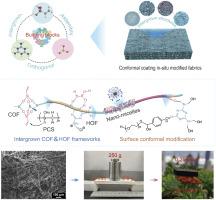仿生燕窝织物和通过正交自组装和保形修饰策略衍生的多功能复合陶瓷
IF 14.2
1区 材料科学
Q1 ENGINEERING, MULTIDISCIPLINARY
引用次数: 0
摘要
轻质隔热纤维复合材料在航空航天应用中备受追捧,但传统的制造方法往往依赖于专门的原料和复杂的纺丝工艺,限制了可设计性和多功能性。在这项工作中,我们提出了一种分子正交自组装策略,用于高效环保地合成COF&;HOF纤维材料。通过仿生学设计灵感来自燕窝的建筑,我们制造先进的织物复合材料通过保形涂层修改。当与烧蚀涂层相结合时,这些织物表现出卓越的动态热管理能力,在丁烷火焰下表现出最小的背面温升(ΔT < 82°C)。热解制得密度低(0.32 g/cm3)、导热系数低(162.0 mW·m−1·K−1)的超轻陶瓷,高温退火制得15R-SiC单晶纤维。此外,耐火化合物的加入使原位转化成为高熵陶瓷复合材料,具有超低密度(0.39 g/cm3),优异的绝热性(173.39 mW·m−1·K−1)和优异的电磁波吸收性。有趣的是,陶瓷化过程触发自发的分层自构建,产生纳米结构,如纳米纤维、带状、球体和纳米线。这项工作为设计先进的人造织物、高熵陶瓷和多功能复合材料建立了一个可持续的范例,这些材料具有适合下一代航空航天应用的特性。本文章由计算机程序翻译,如有差异,请以英文原文为准。

Biomimetic swallow nest-inspired fabrics and derived multifunctional composite ceramics via orthogonal self-assembly and conformal modification strategies
Lightweight, heat-insulating fiber composites are highly sought after for aerospace applications, yet conventional manufacturing methods often depend on specialized feedstocks and complex spinning processes, limiting designability and multifunctionality. In this work, we present a molecular orthogonal self-assembly strategy for the energy-efficient and eco-friendly synthesis of COF&HOF fibric materials. Through biomimetic design inspired by swallow's nest architectures, we fabricated advanced fabric composites via conformal coating modifications. When integrated with ablative coatings, these fabrics demonstrate exceptional dynamic thermal management capability, exhibiting minimal backside temperature rise (ΔT < 82 °C) under butane flame exposure. Pyrolysis yields ultralight ceramics with remarkably low density (0.32 g/cm3) and thermal conductivity (162.0 mW·m−1·K−1), while high-temperature annealing induces the formation of 15R–SiC single-crystalline fibers. Furthermore, incorporation of refractory compounds enables in situ conversion into high-entropy ceramic composites, featuring ultralow density (0.39 g/cm3), superior thermal insulation (173.39 mW·m−1·K−1), and excellent electromagnetic wave absorption. Intriguingly, the ceramicization process triggers spontaneous hierarchical self-construction, generating nanostructures such as nanofibers, ribbons, spheres, and nanowires. This work establishes a sustainable paradigm for designing advanced artificial fabrics, high-entropy ceramics, and multifunctional composites with tailored properties for next-generation aerospace applications.
求助全文
通过发布文献求助,成功后即可免费获取论文全文。
去求助
来源期刊

Composites Part B: Engineering
工程技术-材料科学:复合
CiteScore
24.40
自引率
11.50%
发文量
784
审稿时长
21 days
期刊介绍:
Composites Part B: Engineering is a journal that publishes impactful research of high quality on composite materials. This research is supported by fundamental mechanics and materials science and engineering approaches. The targeted research can cover a wide range of length scales, ranging from nano to micro and meso, and even to the full product and structure level. The journal specifically focuses on engineering applications that involve high performance composites. These applications can range from low volume and high cost to high volume and low cost composite development.
The main goal of the journal is to provide a platform for the prompt publication of original and high quality research. The emphasis is on design, development, modeling, validation, and manufacturing of engineering details and concepts. The journal welcomes both basic research papers and proposals for review articles. Authors are encouraged to address challenges across various application areas. These areas include, but are not limited to, aerospace, automotive, and other surface transportation. The journal also covers energy-related applications, with a focus on renewable energy. Other application areas include infrastructure, off-shore and maritime projects, health care technology, and recreational products.
 求助内容:
求助内容: 应助结果提醒方式:
应助结果提醒方式:


